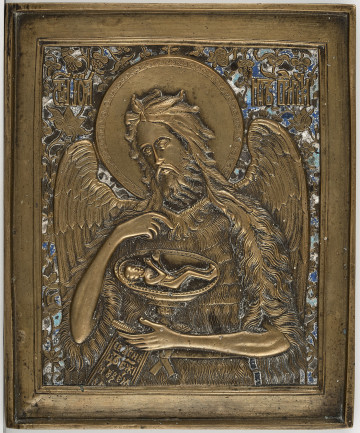
St. John the Baptist
20th century
Castle Museum in Łańcut
Part of the collection: Icons
Images of St John the Baptist, the last Old Testament prophet foretelling the coming of Christ are very popular in the tradition of the Eastern Christianity. John, on a par with the Mother of God, is an advocate for the human race. The eminence of the Prophet was emphasised by Christ: “This is the one about whom it is written: ‘I will send my messenger ahead of you, who will prepare your way before you.’ Truly I tell you, among those born of women there has not risen anyone greater than John the Baptist; yet whoever is least in the kingdom of heaven is greater than he” (Mt 11:7-11). John, born of Zechariah and Elizabeth, a relative of the Mother of God, led a hermitic life, revealed himself at the age of thirty to foretell the imminent coming of the Messiah (Mk1,6; Lk 3,4). For publicly accusing Herod Antipas of incest, he was beheaded in accordance with the wishes of his niece Herodias, who had offered her mother the head of St John (Mt 14,10-12). In the Eastern tradition, the feast of the Prophet, witness of the Saviour’s revelation, falls several times a year according to the Julian calendar (the Gregorian calendar dates in brackets): January 7 (January 27) – Council of St John the Baptist; February 24 (March 8 or 9) – the first (4th century) and second (5th century) discovery of the relics of the head of St John the Baptist; May 25 (June 7) – the third discovery of the relics of the Prophet’s head (9th century); August 29 (September 11) – the beheading of St John; September 23 (October 6) – the conception of St John the Baptist; October 12 (October 25) – transfer of the relics of the hand of St John (to Russia). From early centuries, John the Baptist was depicted as an ascetic with long hair and beard, dressed in animal skins or a cloak and kaftan of camel hair, blessing with his right hand and with a scroll in his left hand. In the Deesis icons, he stands together with the Mother of God by the Throne of Christ (see S.12824MŁ). In the three-winged metal variant of the image, Deesis is depicted in bust (see S.12787MŁ) or appears on independent packet casts, as on the presented icon. Teresa Bagińska-Żurawska https://orcid.org/0000-0002-9243-3967
Dimensions
height: 12 cm, width: 11 cm
Object type
Icons
Technique
cast, enamelling
Material
brass, varnish enamel
Origin / acquisition method
decyzja administracyjna
Creation time / dating
Creation / finding place
Owner
Castle Museum in Łańcut
Identification number
Location / status

20th century
Castle Museum in Łańcut

19th (?) century
Castle Museum in Łańcut

1800 — 1850
Castle Museum in Łańcut
DISCOVER this TOPIC
National Museum in Szczecin
DISCOVER this PATH
Educational path